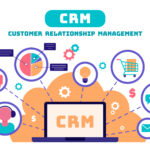Managing the sales funnel is an important part of any business plan that wants to turn leads into paying clients. It means helping potential customers move through the many steps of their buying journey, from learning about your product or service to making a final choice to buy it. Businesses can make sure that no lead falls through the cracks by properly managing the sales funnel. This will lead to more conversions and stronger client connections over time. This post will go into detail on how to manage your sales funnel, giving you useful tips on how to keep your leads moving through the funnel and turn them into loyal clients.
Getting to Know the Sales Funnel
The sales funnel shows the steps a potential customer takes before making a purchase. Awareness, interest, consideration, and choice are some of the most common stages. At every level, businesses may talk to potential customers and help them make a choice to buy.
Businesses may adjust their marketing tactics to match the needs of potential customers at each level of the sales funnel if they know how it works. This method gives organizations the best possibility of converting leads and makes sure they are ready to move leads from one step to the next.
Step 1: Awareness
Awareness is the initial step in the sales funnel, and it’s when people first learn about your brand. This is an important step because it’s when you get a lot of people interested. The purpose of this stage is to get potential customers to know about your product or service and start to recognize your brand.
Now is the time to focus on SEO and content marketing. To make sure people can find your website, social media posts, blog posts, and videos, you should optimize them for relevant keywords. It’s important to give them useful information that answers their inquiries, fixes their problems, or addresses their pain spots. This might be blogs, informative videos, infographics, and podcasts that are made to meet the needs of the people you want to reach online.
Stage 2: Interest
The next step once prospects learn about your brand is to get their attention. At this point, it’s important to take care of the relationship and create trust. Leads at this stage are usually looking for more detailed information about your product or service and are probably weighing their alternatives.
At this point, you could want to use email campaigns, webinars, eBooks, and other gated material that gives more information to get people interested. Giving up free trials, demos, or access to unique content can help you show that you know what you’re talking about in the business and let potential customers see how valuable your service is.
Stage 3: Thinking about it
At the consideration stage, potential customers are actively comparing your product or service to those of your competitors. They are looking at the pros and disadvantages, reading customer reviews, case studies, and comparing features, prices, and benefits. At this point, you want to make your solution seem like the ideal choice for their needs.
Some good strategies for this stage are giving away free trials, consultations, or showing off success stories from customers. Showing how your solution solves a specific problem better than your competitors’ can help people trust you and make decisions.
Step 4: Make a choice
The prospect is ready to buy at the decision stage. At this point, customers are choosing between your offer and the last options. To make sure people take action, you need to give them clear and persuasive calls to action (CTAs) that make them want to act right away.
Offering discounts, limited-time deals, or personalized offers can help you complete the transaction. Also, making the checkout process easier, giving accurate product descriptions, and offering money-back guarantees would make things go more smoothly and raise the possibilities of conversion.
Why Managing Your Sales Funnel Is Important
There are several reasons why good management of the sales funnel is important. It helps you:
- Find out where leads drop off: By keeping track of where leads drop off in the funnel, you may find weak spots in your plan and make changes.
- Improve conversions: If you manage the funnel well, prospects will pass through each stage smoothly, which will make it more likely that they will convert.
- Build enduring relationships with customers: Good funnel management doesn’t just focus on making one-time sales; it also helps you build a long-term relationship with customers so they come back for more.
Segmentation and Personalization
Personalization and segmentation are very important parts of managing a sales funnel. You may make content and offers that speak to each group by dividing your leads into groups based on their interests, behaviors, and stage in the funnel. This method increases the number of people who are interested and the number of people who buy.
For example, you can divide leads into groups like new visitors, engaged prospects, returning customers, or loyal customers. Each group should get individualized communications that meet their demands and the stage of their buyer’s journey.
Automating the Management of Sales Funnels
Automation may make managing a sales funnel a lot easier. CRM solutions like HubSpot, Salesforce, and Marketo take care of important duties like monitoring leads, sending tailored emails, and marketing by email.
Automating follow-up emails, reminders, and lead nurturing campaigns cuts down on manual work and makes sure that no lead is missed. It also makes ensuring that communication is timely and regular, which is important for keeping leads moving through the funnel.
Reporting and Analyzing Data
You need to measure how well each step of your sales funnel is working in order to keep it getting better. You can keep track of important KPIs like these with analytics platforms like Google Analytics, HubSpot, and Salesforce:
- Rates of conversion
- How well do lead sources work?
- How long you spend at each stage of the funnel
- You can find bottlenecks, adjust your strategy, and make smart choices that will help your funnel work better over time by regularly reporting and analyzing data.
How to Keep Your Leads Coming In
It’s not a one-time job to manage your sales funnel; it’s a continuing activity. Here are some useful strategies for keeping your leads moving smoothly through the funnel:
1. Regularly generating leads
You need to keep getting fresh leads all the time if you want to keep getting leads. Paid commercials, content marketing, and SEO are all effective strategies to get new leads. Using more than one channel is important because concentrating on just one may limit your reach. You can make sure that your business reaches a wider audience by using different ways to get leads.
2. Good lead nurturing
Keeping leads in the funnel is important, especially for those who may not be ready to buy yet. Lead nurturing is a big part of this. It means making connections by sending useful information, following up on time, and talking to people in a way that is personal to them. Automated drip email campaigns that give out useful information on a regular basis are a terrific method to keep prospects interested.
3. Follow-ups on time
In the sales process, it’s really important to follow up on time. If someone is looking at a lot of possibilities, they can forget about your brand or get distracted by anything else. You can set up automatic reminders for follow-up tasks using CRM systems so that no lead is missed.
4. Write interesting content
Content that is interesting keeps people engaged in your brand. Blog entries, videos, webinars, and social media posts all give people useful information that helps them make smart choices. It’s important to always give leads stuff that answers their inquiries, addresses their issues, or solves their problems.
5. Give people reasons to do it
Incentives can help get people to buy something. Offering discounts for a short time, free consultations, or product bundles makes people want to act swiftly and move on to the next step in the funnel.
6. Read Reviews and Testimonials
When it comes to managing a sales funnel, social proof is a very useful tool. You may develop trust and credibility by showing favorable customer reviews, case studies, and testimonials. When people see that other people have had good experiences with your goods, they are more likely to buy it.
Making your sales funnel work better to get more people to buy
To make your sales funnel work better, you need to optimize it regularly. To get more people to buy from you, keep testing and changing your techniques. You may find out which techniques work best for your audience by A/B testing your emails, landing sites, and CTAs, for instance.
It’s also important to keep giving your sales team feedback all the time. Their suggestions might help you find things that need work, including changing the language in emails or making the website easier to use.
Final Words
In conclusion, managing a sales funnel is an ongoing activity that demands a deep understanding of how your leads act, good communication, and smart use of tools and automation to keep leads interested. You can make sure that your leads keep moving through the funnel by optimizing each stage and using best practices like segmentation, automation, and timely follow-ups. This will lead to higher conversion rates and steady business growth.
Your business can make a sales funnel that always turns leads into loyal customers if you use the correct technologies, like HubSpot, Salesforce, and Marketo, and always make improvements using a customer-centered approach.
Businesses that want to develop a strong sales funnel need to do more than simply get leads; they also need to keep them interested and help them along their buyer’s journey. Following these steps will help you keep a healthy, high-converting sales pipeline that will help your business succeed all the time.














